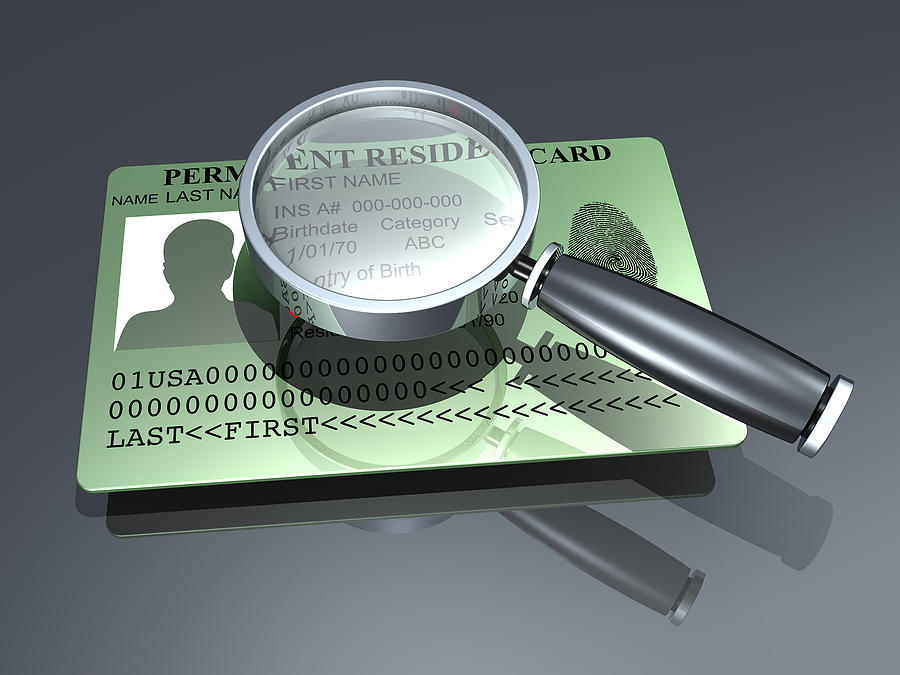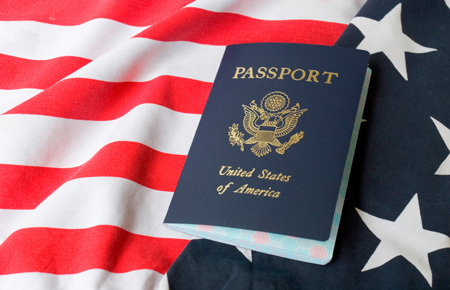 A United States Permanent Resident Card, also green card, is an identification card attesting the permanent resident status of an alien in the United States of America. Green card also refers to an immigration process of becoming a permanent resident. The green card serves as a proof that its holder, a Lawful Permanent Resident (LPR), has been officially granted immigration benefits, which include permission to conditionally reside and take employment in the USA. The holder must maintain his permanent resident status, and can be removed if certain conditions of such status are not met.
A United States Permanent Resident Card, also green card, is an identification card attesting the permanent resident status of an alien in the United States of America. Green card also refers to an immigration process of becoming a permanent resident. The green card serves as a proof that its holder, a Lawful Permanent Resident (LPR), has been officially granted immigration benefits, which include permission to conditionally reside and take employment in the USA. The holder must maintain his permanent resident status, and can be removed if certain conditions of such status are not met.
How to apply for and obtain an
Adjustment of Status
(Green Card)
U.S. Green Card
The official name of the card is Permanent Resident Card (form I-551). The name "green card" comes from the fact that the predecessor, Alien Registration Receipt Card (form I-151) introduced at the end of World War II, was printed on green paper. Form I-551 was adopted in 1977 and has been printed on paper of various colors, none of which were green, but the term "green card" has nonetheless remained in use. As of 2006, the card is mostly yellowish-white and the only prominent green feature is the background of the lettering on the back. A card includes the holder's name and photograph, and other information, and has been updated over the years with numerous anti-counterfeiting devices.
Green cards were formerly issued by the Immigration and Naturalization Service (INS). That agency has been absorbed into and replaced by the Bureau of Citizenship and Immigration Services (BCIS), part of the Department of Homeland Security (DHS). Shortly after re-organization BCIS was re-named to U.S. Citizenship and Immigration Services (USCIS).
An alien with a green card application can obtain two important permits while the case is pending. The first is a temporary work permit known as the Employment Authorization Document (EAD), which allows the alien to take employment in the United States. The second is a temporary travel document, advance parole, which allows the alien to re-enter the United States. Both permits confer benefits that are independent of any existing status granted to the alien. For example, the alien might already have permission to work in the US under an H1-B visa.
Path to US citizenship
An LPR can apply for United States citizenship after 5 years of being in the permanent resident status through the process of naturalization (or after only 3 years if married to a US citizen). Citizens are entitled to more rights (and obligations) than permanent residents (who are still classified as aliens in this respect). Some of the rights include: the right to vote; the right to be elected in federal and state elections; the ability to bring family members to the US; and eligibility for federal government jobs. Other citizenship benefits include no visa requirement for several countries in the world. Certain conditions that may put a permanent resident in the deportation proceedings do not apply to US citizens.
Application process
An immigrant usually has to go through a three-step process to get the green card, which entitles him/her to live and work permanently in the United States (subject to certain rules and conditions). The whole process may take several years depending on the type of immigrant category and the country of birth.
Immigrant Petition — in the first step, USCIS approves the immigrant petition by a qualifying relative, an employer, or in rare cases, such as with an investor visa, the applicant himself. If a sibling is applying, she or he must have the same parents as the applicant.
Immigrant Visa Availability — in the second step, unless the applicant is an "immediate relative", an immigrant visa number through the National Visa Center (NVC) of the United States Department of State (DOS) must be available. A visa number might not be immediately available even if the USCIS approves the petition, because the amount of immigrant visa numbers is limited every year by quotas set in the Immigration and Nationality Act (INA). There are also certain additional limitations by country of birth. Thus, most immigrants will be placed on lengthy waiting lists. Those immigrants who are immediate relatives of a US citizen (spouses and children under 21 years of age, and parents of a US citizen who is 21 years of age or older) are not subject to these quotas and may proceed to the next step immediately (since they qualify for the IR immigrant category).
Immigrant Visa Adjudication — in the third step, if an immigrant visa number becomes available the applicant must either apply with USCIS to adjust their current status to permanent resident status or apply with DOS for immigrant visa at the nearest US consulate before being allowed to come to the USA.
Conditional permanent residence
As part of immigration reform under the Immigration Reform and Control Act of 1986 (IRCA), as well as further reform enacted in the Illegal Immigration Reform and Immigrant Responsibility Act of 1996 (IIRAIRA), persons who are eligible and properly apply for permanent residence based on either a recent marriage to a US citizen or as an investor are granted permanent residence on a conditional basis for two years. An exception to this rule is the case of a US citizen legally sponsoring a spouse in which the marriage at the time of the adjustment of status (I-485) is more than two years old. In this case, the conditional status is waived and a 10-year Permanent Resident Card is issued upon USCIS approval of the case. A permanent resident under the conditional clause may receive an I-551 stamp as well as a Permanent Resident Card. The expiration date of the conditional period is two years from the approval date. The immigrant visa category is CR (conditional resident).
When this 2-year conditional period is over, the permanent residence automatically expires and the applicant is subject to deportation and removal. To avoid this, 90 days or less before the conditional residence expires, the applicant has to file form I-751 Petition to Remove Conditions on Residence (if conditional permanent residence was obtained through marriage) or form I-829 Petition by Entrepreneur to Remove Conditions (if conditional permanent residence was obtained through investment) with USCIS to have the conditions removed. Once the application is received, permanent residence is extended for 1-year intervals until the request to remove conditions is approved or denied. The USCIS requires that the application provide both general and specific supporting evidence that the basis on which the applicant obtained conditional permanent residence was not fraudulent. For an application based on marriage, birth certificates of children, joint financial statements, and letters from employers, friends and relatives are some types of evidence that are accepted. A follow-up interview with an immigration inspector is sometimes required but usually waived if the evidence is sufficient. This is to ensure that the marriage was in good faith and not one of fraudulent means with a sole intention of obtaining a green card. Both husband and wife must attend both interviews under most circumstances. The applicant receives an I-551 stamp in their foreign passport upon approval of their case. The applicant is then free from the conditional requirement once the application is approved. The applicant's new Permanent Resident Card arrives via mail to their residence several weeks to several months later and replaces the old 2-year conditional residence card. This new card must be renewed after 10 years, however permanent resident status is now granted for an indefinite term provided that residence conditions are satisfied at all times. USCIS may request to renew the card earlier due to security enhancements of the card or as a part of a revalidation campaign to exclude counterfeit green cards from circulation.
It is important to note that this 2-year conditional residence period counts towards time as a permanent resident for all purposes including naturalization. However, the application for the removal of conditions must be adjudicated before naturalization can be granted to the applicant.
Maintaining permanent resident status
The card must be in the possession of the US permanent resident at all times. This means that the permanent resident must have a currently valid card on the person at all times and be able to show it to a USCIS officer, if requested. Though aliens with permanent resident status are required to carry these identification cards, American citizens are not required to carry any citizenship identification. Before September 11, 2001, while status was checked when the permanent resident returned from foreign travel, the requirement to carry the green card was practically never enforced when the resident traveled domestically. After that, officials from the DOS began occasionally asking people if they were US citizens or not, and in the latter case require that the person present their Permanent Resident Card or other proof of legal status.
Under certain conditions, permanent residence status can be lost. This includes committing a criminal act that makes a person removable from the United States. A person might also be found to have abandoned their status if he or she moves to another country to live there permanently, stays outside the USA for more than 365 days (without getting a re-entry permit before leaving), or does not file an income tax return. Permanent resident status can also be lost if it is found that the application or grounds for obtaining permanent residence was fraudulent. The failure to renew the permanent resident card does not result in the loss of status, except in the case of conditional permanent residents as noted above.
A person who loses permanent residence status is immediately removable from the United States and must leave the country as soon as possible or face deportation and removal. In some cases the person may be banned from entering the country for 3 or 7 years, or even permanently.
10 Year Expiration Date
In August 1989, the Immigration and Naturalization Service (INS - now USCIS) began issuing "Green Cards" with a 10-year expiration date and required permanent residents to renew their Green Cards every 10 years. In addition, a "Green Card" that is too old, with out-of-date photographs or is damaged, cannot effectively serve as evidence of current immigration status, registration, identity, and employment authorization or re-entry documents. Current Green Cards have an expiration date stated on the front of the card and expire every ten (10) years. The USCIS puts a 10-year expiration date on "Green Cards" for Permanent Residents, not Conditional Residents (2-year expiration date), to protect against counterfeiting and tampering and to ensure that those individuals who may now be inadmissible, removable or deportable are brought to the attention of USCIS.
Disclaimer: Filipina Fiancee Visa Service is not associated with any government agency. Our services include everything you need to get your visa and/or green card, but does not include legal services, legal advice or legal representation of any kind. Filipina Fiancee Visa Service is not a law firm and is not licensed to practice law in any state. Neither Filipina Fiancee Visa Service nor its employees claim to have any special knowledge of immigration law and do not give legal advice.

